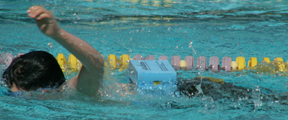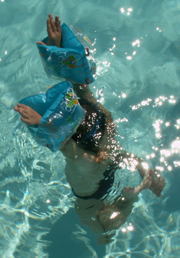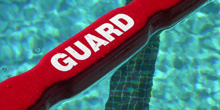These are notes from various staff manuals, personal experiences and the Red Cross texts.

UNSAFE PRACTICES or potential problems TO WATCH FOR:
“Gutter crawlers,” “creepers” or “wall walking” “rope holders” weak swimmers traveling from shallow water to deep water by holding onto the wall, gutter, overflow trough or lane line, or just non-swimmers feeling bold
Corner ‘swimmers’ are people who can’t really swim well and take a big breath near a corner in deep water and try to kick, glide or swim across the corner. Across a short corner they may be successful. But as they gain confidence they try a farther distance than they can hold their breath for or can get off course and not make it to the corner. They will be actively drowning inches from the side.
Non-swimmers bouncing from shallow water toward deeper water
Non-swimmers tip-toeing in almost-too-deep-for-them water
Poor swimmers with ineffective strokes, (arms that do not reach out of the water on the freestyle recovery, or slap straight-armed on entry, for example) or weak strokes that do not propel them far, who stand up frequently (and especially are near a drop off). Especially watch anyone moving from a horizontal to vertical position.
A little child seeming to do a doggie-paddle, but not making forward progress (or in on their stomach in a horizontal position at the surface but not able to raise their face up out of the water) is in trouble.
A child who has wandered away from parents could get in trouble quickly.
Any child holding a kickboard or trying to use a noodle for support is not a great swimmer, and should not be in water that is deeper than they are tall:

Little sibling playing with older child. Older one may lose interest and abandon or not watch the younger one.
Too many kids clinging to one innertube.
Swimming under water alongside the wall (where a patron might be hit by someone who does
not see him or her and jumps into the water)
Placing legs or arms through the rungs of ladders, trying to swim behind ladders or ladder “gymnastics” (keep a snorkel handy if the ladder can’t be easily removed in case they get stuck) and keep a little soap/cooking oil to get them unstuck from gutters
Anyone at a waterfront depending on an inflatable device, especially when wind can take them out farther than they want. Kids playing with inflatables can get in over their heads when wind picks up their toy and carries it away from the shore and they go after it, stepping into deeper water.
Patrons as they first arrive may be overconfident and jump into water depth they are not skilled enough for.
People who use slides are generally less competent than diving board users. Many do not realize if the water at the end of the slide is deeper than they are tall.
If your pool allows small tubes for kids with parents accompanying them, be aware they overturn easily.
Some devices parents think will support their child actually seem to hold their head under water more:

If your pool allows water wings, be aware that they can cause parents and kids to become overconfident and that they can slip up to the child’s wrists, effectively holding the child underwater.


and if we are a weak enough swimmer to need water wings, we need an adult within arms reach of us:

Watch runners and ‘fast walkers’ extra at corners that can get wet and slippery.
Pushing heads underwater
When a crowd gathers it often means unusual, perhaps dangerous activity, or an accident/sudden illness
Swimmers with hair in their faces/eyes that they do not move away because they don’t have enough swimming skill to keep swimming and do so
Swimmers sharing a lane with one of them using hand paddles that can hit another person.
Supersoaker water pistols can injure eyes and cause unsafe running/horseplay.

Accident prevention tips that USA Swimming coaches know:
Take a look around each day and make sure there are no unusual hazards or obstacles on deck. Alert people about any you can’t correct, and/or cone off things like cracked tiles.
Explain all rules of games thoroughly. Anticipate an accident such as a blindfolded Marco Polo swimming into the wall and use lane lines to prevent it. (and even better – trust the player to keep eyes closed rather than actually blindfolding him/her so they can look when they need to.)
Always enforce a feet first entry into the water and that swimmers look at the surface and below surface before entering.
Starting blocks should only be used by skilled swimmers, under direct supervision. When not in use they should be covered or removed so they are not a temptation to casual users.
Be sure backstroke flags are in place and your students know how to use them to predict when they will get to the wall.
Wires should not be laid on deck. Hang them overhead to prevent tripping hazards.

From a City of Santa Clara, California, manual: areas where most accidents occur:
– shallow water where non-swimmers are located
– drop off point, where shallow water gets suddenly deeper
– areas close to side of pool
– areas near ladders (both to boards and from pool)
– deck area at shallow end
– area under boards (no swimming under boards)
– shower area
– directly under lifeguard stand
– black lines on pool bottom

from 2001 City of Cupertino, California, manual:
“Preventative guarding is the key. Yelling “no diving,”
may get tiresome, but doing a backboard rescue is worse. Anticipate dangerous situations and prevent problems.”
“Be aggressive and consistent. Assume control and never relinquish it. Be strict and never let down. Your job is important and you must maintain your authority.”
“When disciplining a patron, please keep the following in mind:
1. Do not become involved in verbal or physical battles.
2. Remain polite, yet be assertive and confident in your decision.
3. If the patron will not comply with your decision and will not leave, call the pool manager for assistance.
4. Be consistent when enforcing rules and taking disciplinary action.”

The following is from the 2001 City of Cupertino manual and is an almost exact copy of
material from a past City of Sunnyvale, California, manual.
1. Children (12 or under)
a. First violation: verbal warning.
b. Second violation: sit on the deck for five minutes and inform the of potential
removal.
c. Third violation: removal for the day.
2. Teenagers and adults (13 and older)
a. First violation: verbal warning and if appropriate, inform them of potential
removal.
b. Second violation: removal for the day.
Minor violations are as follows:
1. Pushing and shoving
2. Unnecessary splashing
3. Running on deck and/or in the locker rooms
4. Diving in non-diving areas
5. Jumping and/or diving in backwards
6. More than one bounce on board
7. Swimming in diving area, except during designated times
8. Leaving diving area in wrong direction
9. Towel snapping
10. Not leaving pool when ordered to do so by staff
11. Splashing guard
12. Smoking on the pool deck and/or locker rooms
Major violations are as follows:
1. Fighting
2. Profanity
3. Molesting children or teenagers*
4. Dangerous diving
5. Use of diving boards which have been declared off-limits
6. Re-entering pool after being removed for the day
7. Use of drugs*
8. Harassing lifeguards
9. Pushing lifeguards in pool
10. Intoxication*
*When molestation, use of drugs, or intoxication occurs, the management will contact the necessary authorities (911). Staff must not make any allegations or statements until asked to do so by law enforcement personnel. An irrational accusation could result in a law suit. The agency will not be responsible for staff members who conduct themselves improperly.
Dismissal of Chronic Major Violators
Disciplinary action for “chronic violators” is as follows:
1. First and second violations: removal for the day only
2. Third violation: removal for one week**
3. Fourth violation: removal for remainder of the summer**
**This should be recorded on an incident report and submitted to the aquatics coordinator at once.
Are you going to allow photography at all at your pool?
Will you ban cellphone use in the lockerroom, since someone seeming to use a cell phone for a phone call could actually be taking pictures of people?
tips for guarding kids’ triathlons
not rescue ready is collection of real, not posed, photos of lifeguards on duty who are not ready to do a rescue, and equipment/facilities also not rescue ready, for discussion in my lifeguard training classes.
lifeguard training, discussing professionalism is an in-service training project, or perhaps for pool patrons, lifeguard candidates who look at this page to consider on their own.
Emergency Action Plan for a coach or swim instructor
Neighborhood Watch applied to swim centers
get ready to take a lifeguard training class
pool rules: attire, health and sanitation
pool rules concerning children
As a head guard or lifeguard manager, which would you choose as a motto for your lifeguards / pool staff?
A) Primun non nocere
(Hippocratic oath)
B) Caveat emptor
C) Interfice errorem, diligere errantem
D) Fac ut gaudeam
E) Castigat ridendo mores
F) Oderint dum metuant
(Caligula (the emperor and the British ship of the line in Captain Hornblower, R.N. by C.S. Forester))
G) Opus: quod fiere non potest

Primun non nocere the first thing is to do no harm (Hippocratic oath)
Caveat emptor buyer beware (he buys at his own risk)
Interfice errorem, diligere errantem kill the sin, love the sinner
Fac ut gaudeam make my day
Castigat ridendo mores laughter succeeds where lecturing won’t…or…only laughter corrects men’s manners/morals
Oderint dum metuant let them hate as long as they fear
Opus: quod fiere non potest Mission: Impossible
——————————————————————-
The author of this webpage, (written as a homework reading assignment for my students), does not give any warranty, expressed or implied, nor assume any legal liability or responsibility for the accuracy, completeness, or usefulness of any information, product, or process included in this website or at websites linked to or from it. Users of information from this website assume all liability arising from such use.